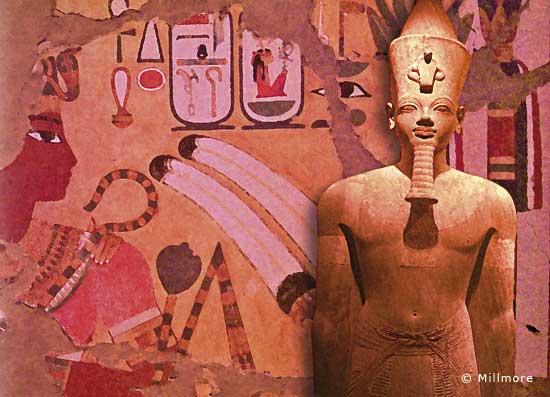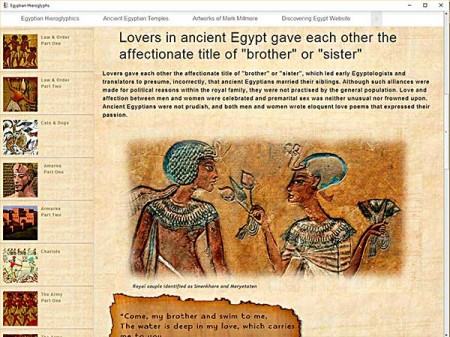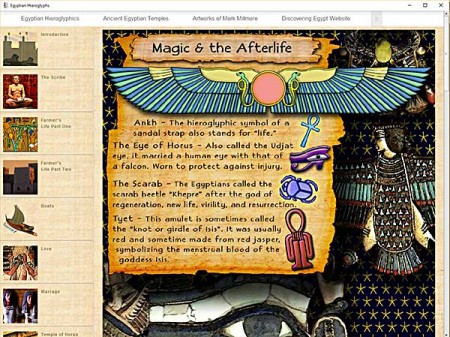Amenhotep III 1390–1352 BC

Amenhotep III was the great grandson of Thutmose III. He reigned for almost forty years at a time when Egypt was at the peak of her glory. He lived a life of pleasure, building huge temples and statues. He was incredibly rich and his palace at Thebes was the most opulent of the ancient world.
With stable international trade and a plentiful supply of gold from the mines, the economy of Egypt was booming. This great wealth led to an outpouring of artistic talent and Amenhotep was the driving force behind this activity. Much credit must also go to the king’s scribe, overseer, and architect, Amenhotep, son of Hapu, who was so highly thought of by the king that he was rewarded with his own mortuary temple.
Amenhotep’s patronage of the arts set new standards of quality and realism in representation. His building works can be found all over Egypt. Many of the finest statues in Egyptian art, attributed to Rameses II, were actually made by Amenhotep III. (Ramses II simply removed Amenhotep’s name and replaced it with his own.) One of Amenhotep’s greatest surviving achievements is the Temple of Luxor on the east bank of the river.
 Unfortunately, his mortuary temple, the largest of its kind ever built, was destroyed when Rameses II used it as a quarry for his own temple. Only the two colossal statues that stood at the entrance survive.
Unfortunately, his mortuary temple, the largest of its kind ever built, was destroyed when Rameses II used it as a quarry for his own temple. Only the two colossal statues that stood at the entrance survive.
In the early years of his reign, Amenhotep was a vigorous young man who enjoyed sport and hunting. In his fifth year as king, he led an expedition to Nubia to put down a rebellion, but there was no need for military activity for the remainder of his reign. Amenhotep favored peaceful pursuits over war—although he wasn’t averse to adopting grandiose names, at one point describing himself as “Great of strength who smites the Asiatics.”

Indulging himself in all the pleasures, extravagances, and luxuries of life were his priorities. He had a large harem that included foreign princesses, though the great love of his life was his queen, Tiy, whom he had married before becoming king. She was a commoner, which was unusual for a chief wife. While most royal marriages were politically motivated, Amenhotep’s marriage to Tiy seems to have been motivated by genuine feeling. He made her a lake 3,600 cubits long by 600 cubits wide (about a one mile 1.6Km in length) in her town of T’aru. He then held a festival on the lake, during which he and Tiy sailed a boat called the Disk of Beauties.
Tiy gave birth to six children: four daughters and two sons. The eldest boy, Thutmose, became a priest and is thought to have begun the tradition of burying the mummified Apis bull, which was believed to be the incarnation of the god Ptah. Unfortunately, Prince Thutmose died, and his brother, the future Akhenaton, ascended the throne.
 As he aged, Amenhotep grew fat and suffered ill health. His mummy shows that he endured painful dental problems. There is even a record of one of his allies, king Tushratta of Mitanni, sending him a statue of the goddess Ishtar for its healing properties.
As he aged, Amenhotep grew fat and suffered ill health. His mummy shows that he endured painful dental problems. There is even a record of one of his allies, king Tushratta of Mitanni, sending him a statue of the goddess Ishtar for its healing properties.
Amenhotep began restricting the power of the priests of Amun by recognizing other cults. One of these was a special form of the god Ra known as the Aten. It was this deity which Amenhotep’s son, Akhenaton, was to promote as the one and only true god, causing trouble within Egyptian society over the next generation. Amenhotep’s greatest legacy was his high standard of artistic and architectural achievement. This sophisticated and refined taste in art permeated Egyptian society and is manifest in the tombs of high officials such as Ramose and Khaemhet. He set the stage for Akhenaton’s unique style and left some of the finest monuments in Egypt. Amenhotep truly deserves the title “the Magnificent.”
Ancient Egyptian Anecdotes
The Ancient Egyptians in their own words
Illustrated Papyri translations edited for the modern reader.







